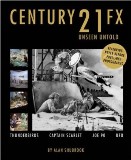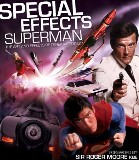| Ian:
Well I’d always been interested in the film industry
but I had no idea how to get into it, so I found myself
working in a factory in Maidenhead doing all the
electrical wiring on missile testing systems. Then one
day my father mentioned that Gerry Anderson had come into
his shop to buy Cuban cigars, this was at a time when
they were making ‘Fireball XL5’, so I
got my dad to introduce him. I told Gerry that I was
doing electrical work but wanted a career in films and he
said ‘Well come and see our electrician because
we’re about to start a new show called ‘Stingray’
, and if he thinks you’re OK there may be a vacancy
for you’. And so that’s how I got my start. |
 |
Ian's photographs
taken on the sets of Stingray.
Above: Director Alan Pattillo looks into the Stingray
bridge set. |
David:
When you joined it must still have been a very small
company.
Ian: Yes, they’d just moved from one side of the
Slough Trading Estate to the other. From Ipswich Road
where I think they’d done ‘XL5’ and
such like, to Stirling Road which was right next to the ‘Mars’
factory - so we used to get the nice smell of the
chocolate bars being made each day!
It wasn’t what you’d call a proper studio as
they were basically single-storey factory units and there
was no height in the ceiling. So that’s why they
later hit on the idea of digging pits in the floor to put
the camera and the camera crew in, so the stage floor
then became the set level giving us more height above |
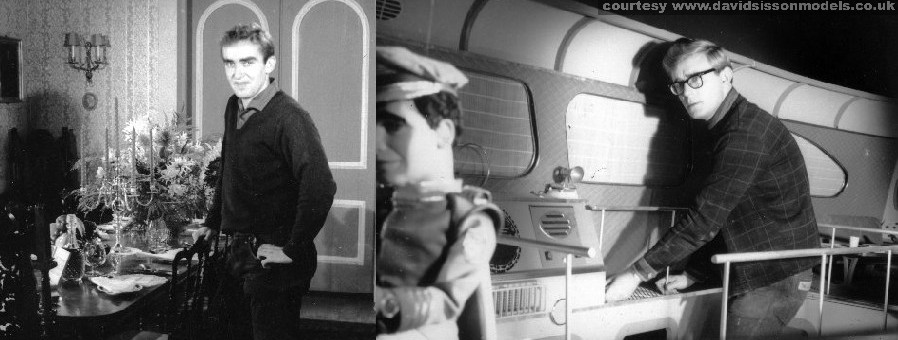 |
Left; Ian in the
full-size set for the episode 'Tom Thumb Tempest'
and Keith Wilson prepares Stingray for action. |
David:
So you were purely an electrician on ‘Stingray’?
Ian: I was just an electrician but I used to help
out any way I could on the stage because I was interested
in the production. Whereas someone else might have just
done his bit of the job and then gone and sat in the
corner, I was always going on and helping the effects
boys out. I’d got electrical experience and used it
to get in the door, but I didn’t just want to be an
electrician.
I’ve always been quite good at art, even back at
school there was talk of me going to Art College but it
never happened, so after ‘Stingray’
finished and ‘Thunderbirds’ began I
managed to get myself transferred to the Art Department. |
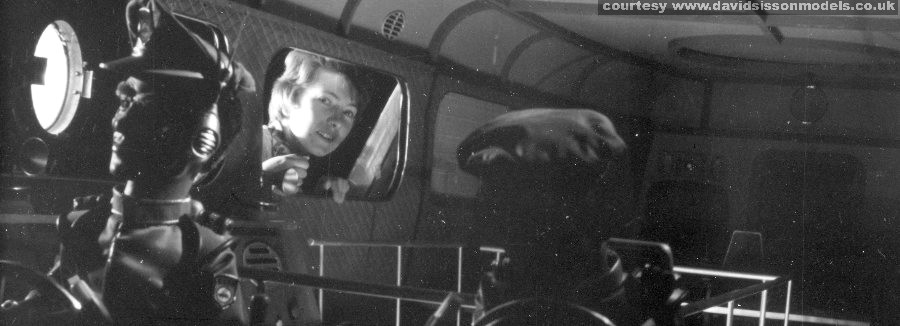 |
David:
What exactly does the Art Department do and how long did
you stay there?
Ian: I think I was probably in that
department for about six months. Basically they design
and then organise for the sets to be built, run the
decorating for the sets, what the backgrounds are going
to be, all in consultation with what the director and the
producer wants and depending on what the action calls
for. Then when the set is built it has to be dressed. So
if it’s a room they have to decide what ornaments
they want in it, what pictures you want on the wall, what
furniture to use and of course does it suit that period
or the style of house. So in many ways the decisions the
Art Department makes sets the tone of the whole picture.David: ‘Thunderbirds’
started as a half-hour program then expanded to be an
hour long. I assume at this stage they had to take on a
lot more staff, or open up more stages to shoot on.
Ian: Yes they did, I think they expanded
into the buildings next door if I remember correctly. We
had two quite large buildings, one was for the puppets
and then we had one with three stages for the special
effects. Two of those stages were for shooting the main
effects and then one was what we called ‘The Flying
Unit’. Peter Wragg usually directed this and it had
the rolling road and the roller backing on it.
|
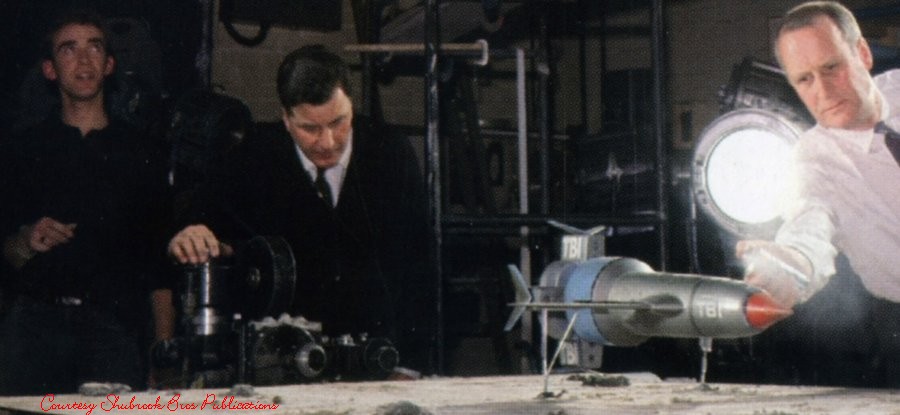 |
| Above left; Ian
keeps his eye on the assistant holding the model's
support wires |
David:
Was it your idea to now get into the Special Effects
Department?
Ian: Well yes
and no. They had fallen behind on ‘Thunderbirds’
because the special effects were far more complex than
what had been done before. They had actually fallen well
behind and the only way they could really catch up
was to start another unit.
The idea was for Derek Meddings (the Special Effects
Supervisor) to come back onto the studio floor, because
at that time he wasn’t on the day-to-day filming he
was off doing the overall designing and organising of
everything. So they asked us for volunteers to man this
new unit and so that’s how I started, working
directly with Derek, which was great because he taught me
a lot.There was a chain of command, Derek would be
at the top and he designed everything and did the
original concept. Then there would be a couple of other
guys below him, one of which would be Mike Trimm who
helped design models, and then below them there would be
the directors of the three units doing the day-to-day
work. And then below them they would have their crew of
normally about three or four guys.
|
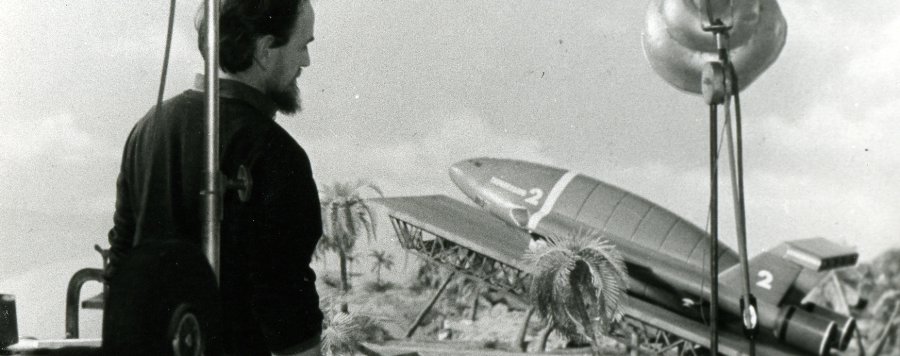 |
David:
Did they pick different crews each week?
Ian: Mostly when you started with a crew you would
stay with them. Jimmy Elliott was one of the long-time
crew directors and Shaun Whittaker-Cook (pictured above)
was another and normally if you started with one of those
you would stay with them.
Shaun Whittaker-Cook was very ‘arty’ and very
posh compared to the rest of us. He didn’t use to
walk he used to ‘shuffle’ across the floor
(laugh). He was a lovely guy but he seemed a bit out of
place compared to the rest of us, a bit of an odd-one-out
really but he was about ten years older than most of us.
Jimmy Elliott was also a bit older and he was a real
character; one of the funniest men I’ve ever met in
my life.David: How was Derek Meddings to work
with, was he a good boss?
Ian: He was good. He was hard - he was one of these
that always used to say to us ‘Anticipate my next
move’. So in other words if I need a screwdriver in
my hand have that screwdriver ready to give to me, so
when I hold out my hand its there.
He was a hard taskmaster, he really could be, but he had
a lot of pressure on him because we had a schedule to
keep, and we had to get it all done, but in other ways he
was marvellous.
It was
quite funny because Derek was one of these guys who
always looked smart and never got dirty. At the end of
the day we’d be looking like tramps and Derek still
looked smart, I said ‘I don’t believe you
Derek, look at the state of us and you look
perfect’. The truth is he was probably as dirty as
the rest of us because he never shirked getting stuck in,
he was usually the first in there but he just always
looked clean and smart!
He was
also a great guy for thinking up shortcuts, that’s
what he was very good at; he was great at getting things
to work.
|
 |
Above, the Monorail
train in the Thunderbirds episode 'Brink of
Disaster'.
SFX Supervisor Derek Meddings centre front. |
David:
How would you start each day, would you review the film
that you had shot previously?
Ian: Yes, you
usually went into rushes and saw the film from the
previous day (or even earlier that day) and decide if it
was passable or if we had to re-shoot. I must say that
the operation became pretty slick because you had a good
team of boys who had been there some time and we were
usually pretty good at what we were doing. There were
some re-shoots because you would go to rushes and maybe
see some silly little thing that you didn’t like and
if the set was still there then you could re-shoot, but
often the set wasn’t there and you had to evaluate
if it was worth rebuilding. Once again it’s the old
thing of schedules and money, because you had to stick to
a certain schedule and get a certain amount of shots done
each day.David: Did you usually manage that
or was there a lot of overtime?
Ian: There was
a reasonable amount overtime, it would come at times when
you’d get the odd episode that was probably a bit
trickier than normal, say like ‘Attack of the
Alligators’. I think we actually worked day and
night on that through a weekend because we were using
live alligators in the water tanks. Those alligators - or
crocodiles I believe - were quite difficult to control.
When we put them in the tank they would disappear and you
wouldn’t see them for hours at a time, and then
suddenly they’d come up and all you could see were
their two eyes. Obviously for a film you wanted to see
more of them than that so we tied them to the puppet
control poles and pushed them out into the middle of the
tank, so that you could see more of their bodies,
otherwise they just didn’t want to perform. Maybe we
weren’t paying them enough (laugh).
These things varied in
size from about two-feet long to one that was four-foot
long; that one spent most of the day sat in a box at the
back of the stage and we covered it in wet rags to keep
it moist. Over a period of several days you would forget
that it was there then one day someone shouted ‘Look
out’ and we turned round to see this big crocodile
walking across the stage – which cleared of people
very quickly!
Then there was the day when they were shooting some
publicity photographs with it and a puppet of Lady
Penelope. The puppet was standing right next to it and
this crocodile was absolutely static, it was just stuck
there without a single movement for what seemed like
hours. Then suddenly it just turned round and got hold of
this puppet and violently shook its head several times
and there were bits of puppet flying in all directions
(laugh). And I can remember the puppeteer, who was
Christine Glanville, was in tears because this puppet was
her baby. Poor Christine, but that’s the fun of
filmmaking!
|
 |
David:
Was everything you did storyboarded?
Ian: Yes, that was very important, and we had to
keep to those storyboards especially with model work like
that. Now and again you may deviate a bit but basically
that was our shooting bible.David: Was
there any competition between the units to see who could
get the best shots?
Ian: Oh yes, definitely, it was very competitive
in that way and quite honestly we really loved what we
were doing from a work experience. We were all still
young and impressionable in those days and it was
fantastic - and it wasn’t like work in many ways.
David: Did you have any particular
friends on the crew?
Ian: Well I don’t know how they all
originally started but there was a group of guys who came
from the Victoria area in London, Bill Camp, Ken Turner
and Alan Berry and they became very good friends of mine.
Jimmy Elliott was a very good friend too, and at one
point I shared a house in Cookham village with Brian
Loftus, Ian Scoones and Keith Wilson - who sadly died
just recently.
All these guys were good friends, so much so that one
year a big crowd of us all went down to Spain on holiday
together. There were two or three different groups but it
was the sort of place where we just all got on.
David: Roger Dicken worked on ‘Thunderbirds’
for a bit didn’t he?
Ian: Yes, he dressed like a Rock-and-Roller and
was the most unlikely person that you would expect to
make animated models. He was very good at his job and he
was so into Prehistoric monsters, animation, Ray
Harryhausen, and all that.
But he lived on his nerves and Derek would come into the
workshop and say ‘Come on Roger we need that model
now’ and Roger would be getting all upset that it
wasn’t ready and the two would be arguing, and of
course we (the crew) were terrible and we would try and
wind both of them up just for the laugh. The pair of them
was so funny.
David: What sort of day-to-day jobs
were you expected to do there as an Effects Assistant?
Ian: Well it was a bit like a film school for
effects men really because we did a bit of everything, so
it was like a training facility. Because it was such a
small studio we could become involved in everything, we
learnt by looking through the cameras and sometimes even
help operate them. You learned more about lenses and such
like, leant about different camera speeds for different
shots, you were rigging stuff and doing scaffold work,
slinging lines across to fly the models. You would never
get that experience as a special effects technician
working on a big movie so it was very varied - plus the
explosives, the pyrotechnics, that was obviously a new
area to me.
|
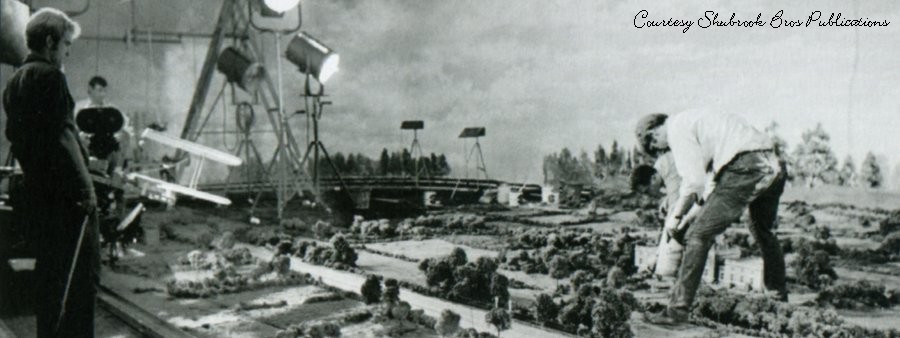 |
David:
Did you have a daily target for how many shots you had to
achieve?
Ian: Yes we did, but don’t ask me what it was
as it did vary a bit. It was hard going, it really was,
we got there first thing in the day and we didn’t
stop. And the other thing was that we had to build the
sets ourselves, we didn’t have a construction crew
come in and build the sets for us - we did the lot.
It was building the sets, modelling the background, even
getting involved in painting the backings. Then you had
to dress the sets, like if you were doing a big street
scene you would be putting in the buildings and laying
down grass (using special grass mats) and then dress and
paint the edges of the road using lots of powder paints,
and dressing the landscape to get the distance on the
shots. It was very hard work and so by the end of the day
we would be covered from head-to-foot in dirt and powder
paints, and it got so bad that they actually had to
install showers for us because we couldn’t leave the
building in that state every day.David: So the landscapes were
literally just thrown together from a collection of bits?
Ian: Yes, all the rocks were sculpted from
polystyrene and we would have a stock of these, all
different sizes and colours, which we kept just outside
the stage door. And we would go out and bring them in,
set them in place by trying different ones and dressing
them to camera, thinking ‘That looks good’ and
sending someone to go and have a look through the camera
and tell you what it looks like. Then you would dress the
floor using a lot of silver sand, nearer the camera you
would use the very small-scale grass matting and for the
most distance stuff you would use coloured powders.
If we
were doing the road we would colour the roadway not with
paint but usually with grey and black powders. And you
would put in the wear marks in the road where the cars
had been; again doing it using brushes and powder paints
so it was quite artistic to do that sort of stuff.
|
 |
| Behind the model
mountains we would have cutouts of painted mountains and
behind that we would have more mountains painted on the
actual backing. There used to be a lot of work involved
in doing it and we all used to jump in and get involved
with doing the colouring of the set, which often meant
changing the colour of the rocks if they didn’t suit
that particular story. The rocks might have been in a
desert the previous episode, or the Moon, so you had to
get a spray outfit out and change the colour to suit the
episodes requirements. We used to use different scales of
grass matting and lots of real stuff too, like lichen.
That was a great lifesaver because you could use it for
trees and hedges. For some trees we would build them from
real bits of small tree branch and then spray them with
this white adhesive material, I can’t quite remember
what the product was but it was a bit like the
snow-effect stuff we use today. Anyway we would spray
this stuff onto the branches to create scale leaves and
then spray it all green, and that used to work quite well
for us.
David: The sky backgrounds always
looked very good.
Ian: Yes, I’d say the person who did more of
those than anyone was Derek himself; he was a very good
artist because that was his background originally. He
started out by working with Les Bowie who was originally
a Matte artist and Derek was to have carried that on, but
then like Les he moved on to more general effects work.
David: Did you ever have problems
getting shadows on the backdrops?
Ian: We often had problems, if you could you would
do a dry run to see if you got a shadow, but that
wasn’t always possible. It was one thing that the
Lighting Cameraman had to deal with all the time. They
would often light to eliminate the shadow altogether or
have the shadow appear well after the shot, in other
words the shot was through and gone before the shadow
appeared on the backing.
|
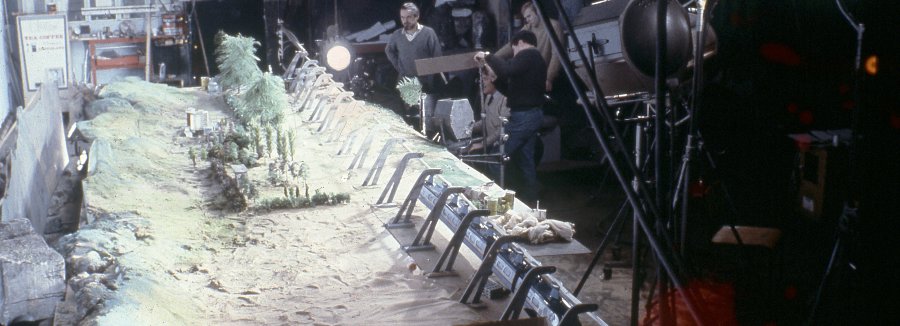 |
David:
Who came up with the idea for the rolling backdrop?
Ian: The idea
wasn’t new as it had been used in films back in the
1930s, although it probably just had a bloke with a
handle and not a motor like ours. We also had the
horizontal one, which had an attachment to it so that
there would also be a foreground one that ran at a
slightly different pace.
I can remember working on the episode where the big plane
(the Fireflash) had to come down and land on the
vehicles, that was a pig to do, getting it to land and
everything to work right. You had the models on thin
tungsten wires and if one of them broke your model would
go ‘whoosh’ past your head (laugh) and you were
picking up the pieces, then into the workshop to get the
glue out. But it did all work out well in the end.David: Did
the belts ever come off?
Ian: We did occasionally have problems; the sky
backing was the worst one because obviously gravity was
pulling it down. It was made from rubberised canvas and
it was on rollers that you could tension at each end to
hold it up there, but it did move down. At a later stage
it was modified and wheels were put around the top to
support it and stop the problem.
David: I guess that one of your jobs
would have been to light the Jetex motors, I assume that
they were ignited manually?
Ian: Oh yes the Jetex motors, we used those in the
models to kick up dust under the vehicles as they went
down the road. We probably sent Jetex shares soaring at
that time for the amount we used (laugh). Basically it
was just an off-the-shelf product made of cheap
bronzed-metal, it came in two halves and it had a spring
clip on the top that you would latch over. You would put
the two Jetex rocket fuels in there, half pellets (bit
like slug pellets), and then you put a fuse filter in
there, coil it up and poke it through the end, put the
lid back on, clip it over and fix it into the vehicles
with little spring clips. It was usually lit by hand, not
electrically, usually by leaving out a trailing fuse or
by poking a light underneath. We’d dust the road
with powder paint, lit the fuse, turn over the camera,
and then pull the model car down the road and so
you’d get all this dust flying up, which gave it
some action and made it look more realistic.
David: In Alan Shubrook’s book
Century 21 FX: Unseen, Untold there’s a good picture
of you trying to catch the big
Thunderbird 2 as it leaves the
launch ramp (feature film version). Was catching the
models a common job?
|
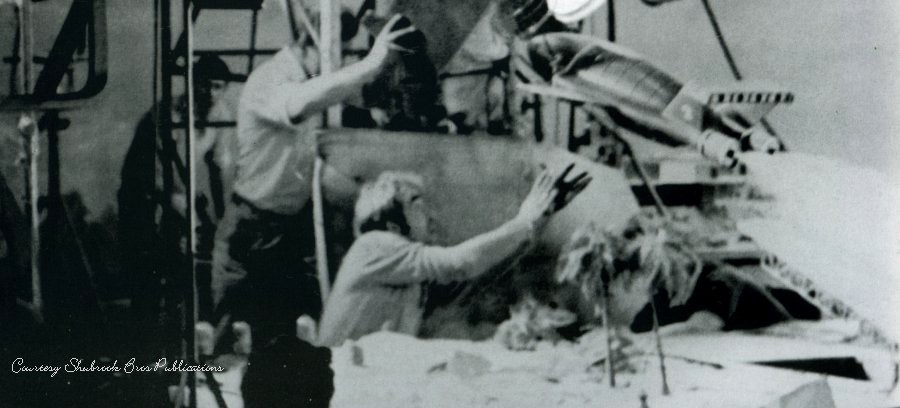 |
| Ian: Yes, you
usually were due to the space restrictions in the studio.
If you were shooting at high speed and you wanted a model
to come through fast you had to get it up to speed very
quickly. We pulled the models through on running wires,
we had a running wire above, a very taught piano wire,
and we used to run a tube along it with the model hanging
from what we use to call a crucifix with screw-eyes in.
That model had to get up to speed very quick,
because you’re shooting at high speed, and
you’ve got to stop it quickly as well. So these
things were hanging there on very thin tungsten wires and
so we use to try and catch them, to save them from
smashing into the tower that was supporting the wire and
also to try and stop the wires from breaking. Because you
often wanted to do a second take and you don’t want
to have to rewire the model again. So it was very
important that you caught this thing. David: Did
you ever build any of the models?
Ian: No not a
great deal. I wasn’t involved in the model workshop,
I used to get involved in repairing them but I
wasn’t actually one of the model makers. If I
remember rightly Ray Brown ran the Model Workshop and
there was also Peter Ashton and they were both very good.
David: Apparently some of the models
were made from Balsa wood at the beginning to keep them
light, before fibreglass ones were used?
Ian: That may have been the case, but Balsa wood
didn’t necessarily make the models lighter because
you can’t always get the very thin shapes, or the
finish on it, that you can get with a fibreglass model.
And the fibreglass ones were actually pretty light.
The
worse one was Thunderbird 2, because it was so big
it was quite heavy and then on top of that every time it
crashed down on the floor it was a case of rushing it
into the model shop for a quick repair with Cataloy (car
body filler) and then back onto the set. As time went on
this model actually got heavier and heavier (laugh) and
it was falling off as much as it was staying in the air!
So it was almost counter-productive to repair it in this
way, but that’s how it happened.
David: I guess the models were
designed to look good and so were not always very
practical. I was looking at the Crablogger
photos and thinking how was such a massive model moved
through the scenes.
|
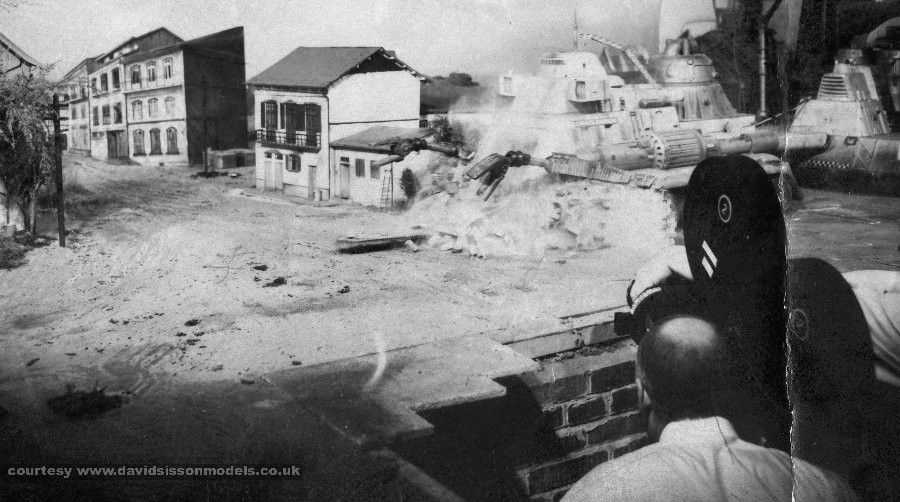 |
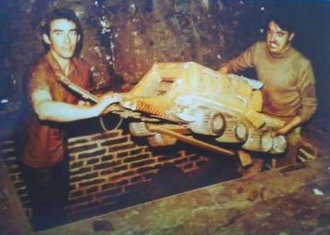 |
Filming the
stunning 'Crablogger' miniature for the Thunderbirds
episode 'Path of Destruction'. The vehicle is now
out of control and plows through the town of San
Martino. The effects camera crew are in a pit
that was specially dug into the studio floor to
allow the camera to be as low as possible when
filming the models.
Left;
Ian helps to remove the wrecked model from the
pit.
|
|
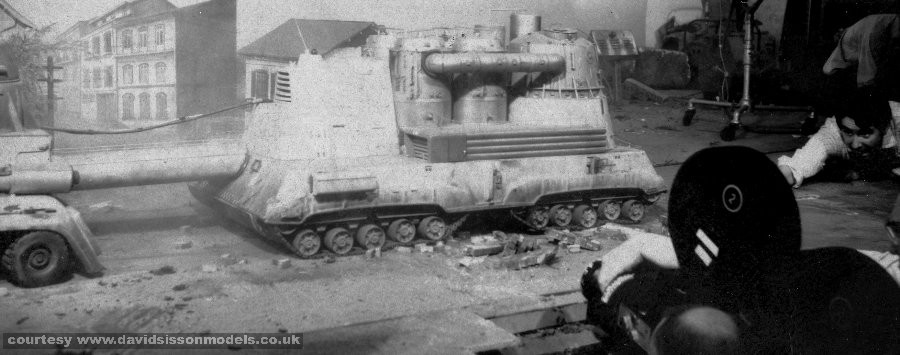 |
| Ian: Well if we
didn’t use a wire there were often times when we
used to just push these models in, we would have a rod
and hide it down the back and push it along. Or we would
have a rod going down through the set and someone pulling
it through. It was
harder to get the models to turn, the vehicles all had
small axles on them with a bit of steering so the wheels
could turn and suspension, which was usually done with
foam rubber, to get the movement. Basically we had a slot
in the centre of the set and they were pulled by someone
underneath, or someone at the side.
We had a system (which worked on the overhead models as
well) that if a model was on a wire and we again needed
to get them up to speed we would use bicycle wheels, and
we put a little drum on the bicycle wheel so it was like
a gear, so it was 2:1 or 6:1 or something like that. So
you pulled the cable on the small drum and just ran with
it and the model wire was attached to a large drum, so
this gearing allowed the model to get up to speed very
quickly.
There were times when you had a very long run and you had
to run out the stage door and into the corridor just
pulling this model. The fact is we didn’t have the
time or money to get more sophisticated than that, it was
pretty much all manual where possible. We did have motors
on a few things - but very few things!
David: When people talk about wires
they often think of just fishing lines.
Ian: It was
fishing lines, steel cables, string, it was all different
things depending on the time we had. We had one
particular cable that we used a lot to pull stuff on and
that was called a lay-flat cable, which was very thin
bonded wire. We used that mainly because it didn’t
stretch and we got better feedback through it, whereas if
you used a fishing line it would be very bouncy.
With the tungsten support wires we could feed electrical
power down to the models, but if you used too much power
they would just burn out and snap and down would go the
model. So you had to know just how much you could use
because most of the time we over-ran all the bulbs in the
models, in other words if it was a 6-volt bulb we would
run it up to 12-volt or even more to make it as bright as
possible. But by doing that it became quite easy to use
more power than the tungsten wire liked then puff it
would burn-out, especially if it was under tension which
it usually was.
|
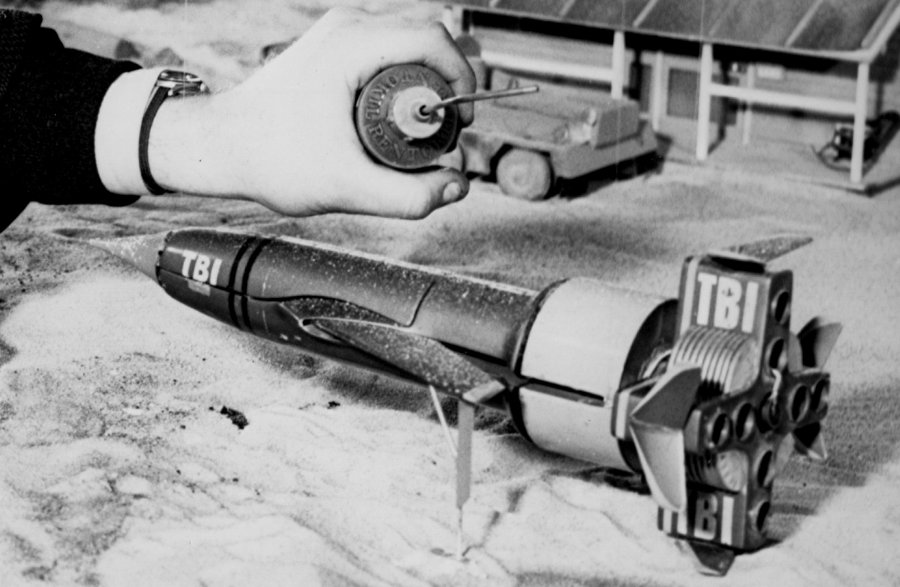 |
David:
How did you attach the wires to the models?
Ian: A lot of
the time if there wasn’t a little hole or something
we would put little dress pins into the model, and just
go round the pinhead. But where you had to be careful
with tungsten wire is that you mustn’t kink it, you
must not turn it back on itself, or it just breaks very
easily. That’s actually how we used it, once
we’d run a length out we would just kink it and it
would break. But obviously you didn’t want that to
happen on the model so you had to be very careful how you
tied it on and we used to use things like a
Fisherman’s knot where you wouldn’t kink it.
With some models, like Thunderbirds 1 and 3,
you could attach it with a single wire through the nose.
On the take-off shots we use to try and get it so that
the support wire was directly above the model so that it
wouldn’t want to move in any other direction. But
sometimes you did see the odd one where the model used to
spin a bit, but we usually got it looking pretty good
with the rockets firing underneath.David: Did the person holding the
model activate the rockets?
Ian: No that
was usually done by someone else. On some models we had
to run the feed down the wires but at other times, like
the Thunderbird 1 take-off, we would put the
electrical ignition up through from underneath the set
and into the rocket pod, so that wasn’t actually
attached to the model and that was the easier way of
doing it. (This can be seen in some episodes as a
burning wire protruding up from the landscape set.)
David: Has anyone ever pointed out
to you that the four rockets that fired when Thunderbird
2 landed, or took-off, were actually
put into the holes for the legs – not the holes for
the thrusters!
Ian: I’ve never given that any thought to be
honest, and I don’t think anyone else ever did!
(laugh)
I mean Derek designed all these models but he wasn’t
actually very practical as such, so perhaps he
didn’t think of it and nobody else did.
David: Were you often pulling the
models along?
Ian: Oh yes I
was, there were certain people who were good at flying
the models and pulling them along. I seemed to have a bit
of a talent for it so I often became one of the
operators; another person who was good at it was Peter
Wragg.
This wasn’t always a good thing because you usually
ended up on top of the tower holding Thunderbird 2
or one of the others. I keep harking on about Thunderbird
2 because it was ‘The Pig’ of all the
models, it was a nice model but it was so big and
heavy and you used to be standing out there holding this
thing from the wooden crucifix (with the four wires
hanging down) and you were standing out on a plank that
was bending under the weight – it was almost like
walking the plank on a Pirate ship! And not only that but
this plank was tied to a tower, and we used to put a
couple of big steel oxygen bottles on it to
counter-weight it, but the trouble is that often you were
so far out that the tower was starting to move a bit. So
you were on a plank that was bending, on a tower that was
moving, and you were out there holding a very expensive
model with your hands actually shaking from the weight.
And you also had to hold it most of the time because they
were colouring the wires – we had powder puffers,
and powder paints with different tones and they had to be
applied to match the backgrounds. And so with a
combination of lighting, the puffers, powder paint and
anti-flare spray we used to get rid of the wires, because
in those days we didn’t have CGI to get rid of the
wires we had to do it live on the set.
|
 |
David:
I think Derek also referred to Thunderbird
2 as being a bit of a pig too!
Ian: Well Thunderbird 2 had the highest
failure rate just because of its bulk. If it had been a
real vehicle I don’t know how it could have ever
flown quite honestly (laugh) but that probably goes for
all of them up to a point. Thunderbird 2 was the
hardest one and it was the one that was used more than
any other, it was in every episode and with different
Pods.David: Talking of Pods, how
did it actually stay in position, did you just normally
jam something like Plasticine (modelling clay) into the
gaps to hold it?
Ian: You know I can’t actually think back on
this one, I was hoping that you wouldn’t ask me that
one (laugh). The Pod was fibreglass and too heavy for
Plasticine to hold it. There was some sort of bracket but
I can’t remember if it was underneath or inside, but
we did use something to secure it.
David: In a lot of these
behind-the-scenes pictures we can clearly see the roof
and the crew are actually up against it.
Ian: Oh yes that’s right, we were up in the
roof and all the heat just went up there too. Because we
were shooting high-speed there were two or three times
the amount of lights as normal and it was HOT, most of
the time we just wore shorts and nothing else and the
sweat was just pouring off us!
David: Did they have extractors
installed?
Ian: There were extractors there but as you know
extractors never seem to do what they claim. I’ve
been going into different buildings all my life,
especially on film sets and big stages like Pinewood and
Shepperton, and you hear the extractors roaring away but
the smoke and fumes seem to stay exactly the same. So yes
they did have extractors, but because we used to need
black smokes in there - which to make black smoke you
have to burn something, usually from smoke candles - and
white smoke and do explosions with naphthalene the
atmosphere inside those buildings was pretty grim at
times.
David: Did you usually wear masks?
Ian: We did have masks but at times they were just
impractical to use. We used to do explosions and because
the stuff was so close to us we all wore protective gear,
helmets, facemasks, fireproof jackets, because we were
really close to these things. It wasn’t like the
explosion was in the field next-door you were almost in
amongst it. It was miniature stuff and it was right close
to camera and we were doing it in buildings that really
weren’t properly suitable for that type of work.
So at the end of the shot it would be ‘CUT’ and
there were times when you just stood there and you
couldn’t see where you were, you didn’t know
which way to turn, because the smoke was so thick. And
you had to wait for someone to open a couple of big doors
and put on some fans to blow it all out of the building.
David: So how big were these
explosions and did you mix them at all?
Ian: Well some of them usually used to hit the
roof – although the roof wasn’t that far away!
We were all allowed to do it and some people got into it
more than others. I used to love learning how to mix it
up. There was an art to doing small explosions as opposed
to the big ones; I think its harder in many ways.
|
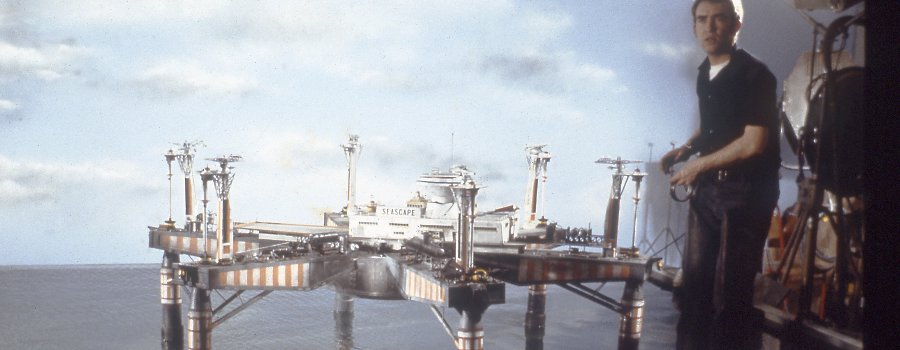 |
Ian standing in the
water tank, as he prepares the Seascape oil rig
model
for the Thunderbirds episode 'Atlantic Inferno' |
David:
Derek sometimes called them ‘soft explosions’,
did they have much power to them?
Ian: Well they could have power. When he says
‘soft’ it usually means a pyrotechnic which is
a powder, like black powder etc. And when you say
‘hard’ you usually mean high-explosive, which
is dynamite, plastic explosive, and things like that. You
can make a little charge quite dangerous, or bigger, by
just ‘tamping’ it. Tamping means either
wrapping it much harder or putting it in a confined space
so that it has to work harder to get out.David: And they worked fine in the
water tank?
Ian: Yes they
did work in the water if you could keep them dry before
you let them off, which we did in various ways like
putting them in bottles and such like.
David:
I noticed in some of the shots in ‘Captain
Scarlet’ that when an explosion
occurred all the powder paints on the floor would lift
into the air, which looked very realistic.
Ian: That was
basically the shockwave from the explosives, sometimes it
used to work for us and sometimes it didn’t and that
used to work quite well. Sometimes things happen better
than you think they would, and occasionally unexpected
things would happen. At times you can spend hours trying
to get something to work and then something else would
just happen spontaneously.
|
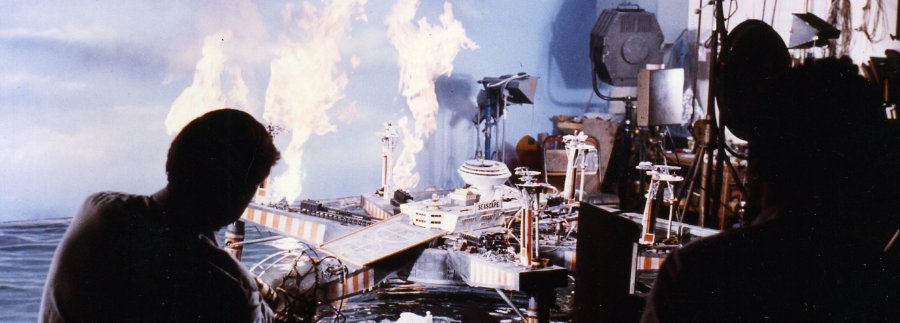 |
| John Richardson who did
the first ‘Omen’ film, where they cut
the head off on the pane of glass and then the head spun
on the glass, said to me ‘We didn’t do that, it
just happened’. Everyone said that it was
‘Terrific’ but he said they just got lucky!
Funny enough I thought Derek was one of the luckiest
special effects guys I ever met because when we did
things we would say to him ‘Shall we do this, and
that, to make sure that it works’ and he would say
‘No forget about it’ and it would work just
fine. But if you did it the next day it
wouldn’t work at all, he was lucky that way. David: Did things ever go wrong?
Ian: Sometimes.
I remember a time on ‘Stingray’ with Ian
Scoones when there was an underwater shot where one of
those Terror Fish was blown up by a missile. We
were filming through the fish-tank and we had this
missile coming in on a wire where it hits this model and
then goes BOOM. As soon as this happened we were to cut
the support wires to make the model drop, and that model
wasn’t rigged on the overhead wires but a horizontal
wire because the idea was that it was easier to cut that
wire and get the model to fall cleanly. I can remember we
spent hours getting this thing prepared, it was a real
tricky shot to do, we got it all ready and then the shout
came ‘Turn over’, so the cameras are running
but then something was wrong so the call went out
‘CUT, CUT’. So Ian thought it was his queue and
cut the wires - silly boy. Old Derek was livid and shouts
‘SCOONES YOU’RE A C**T! (laugh).
It was hilarious, but we all ended up doing things like
that, it had to happen, it was inevitable when you were
working at that pace. Sometimes we would do five major
shots a day and it was a lot of work, and as soon as
you’d done one it was right strip it down, sling it
out, and get the next one in. But we did have fun too.
|
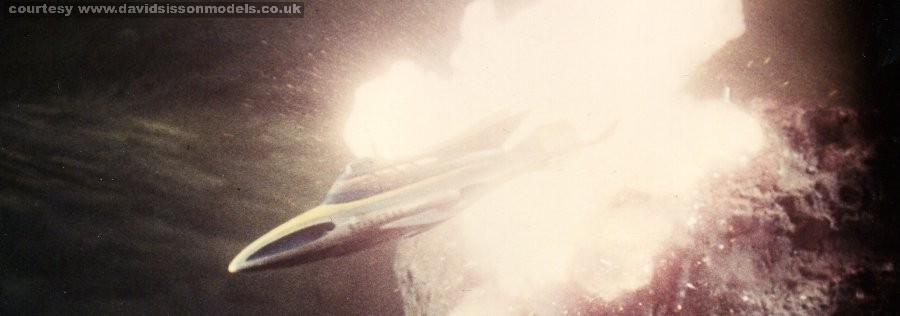 |
David:
They started making Thunderbird
feature films, do you remember much of this. You did
actually get a screen credit for ‘Thunderbird
6’, did that mean you got more
cash?
Ian: I can’t remember getting more cash (laugh)
but yes I did get a credit, prior to that not many of us
got screen credits. That was in the days when you go to
see a film at the cinema and only the special effects
supervisor usually got a mention.
I did a little bit of work on the first one, but I was
sort of in-and-out on that. The first film was more Shaun
Whittacker-Cook and Richard Conway, I would just come in
if they needed more hands on it – I remember being
involved when we were letting off all the fireballs with
the Rock-Snakes on Mars. |
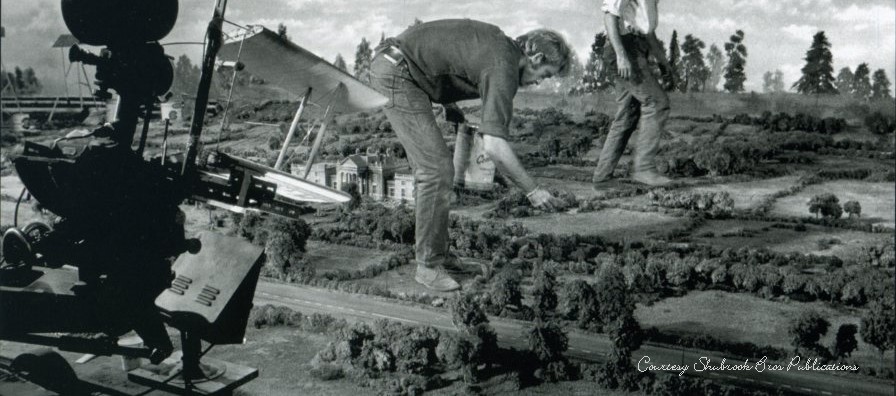 |
Above; Ian (centre)
working on the set during the filming of 'Thunderbird 6'.
The camera shoots
through a partial model of the Tiger Moth wings to get an
aerial view of Lady Penelope's home. |
David:
So you couldn’t answer the question ‘Why was
Mars Grey?’
I mean they fly to the Red
Planet and it looks just like the Moon!
Ian: I
can’t answer that one, I can’t remember if we
had photographs of Mars at that time so we obviously
didn’t know if the surface was actually that red.
Maybe they did tests using different coloured surfaces
and they found out that it really didn’t work, or
perhaps it was the most practical and best looking for
that scene in the film. David: Did the team split
at this point because ‘Captain
Scarlet’ was being done around
the time of the later Thunderbird
film?
Ian: Yes, I
started on ‘Captain Scarlet’ but Derek
was going to direct the effects on ‘Thunderbird
6’ and he asked me to go on it with him. ‘Thunderbird
6’ was good because obviously the budget was
higher than normal and so you got to do things bigger and
probably better than you had done before. For example we
built a very big-scale motorway bridge out in a field
near to Booker Airfield at High Wycombe, so that you
could use the real background and sky as part of the
model shot as we flew the model Tiger Moth underneath the
bridge.
They also did it for real as they were still building the
M40 motorway at that time. They got a pilot, called Joan
Hughes, and she actually flew the plane underneath this
new motorway bridge. She wasn’t supposed to as she
was only supposed to taxi it and the Ministry man, who
was there at the time, went absolutely bananas (laugh),
but she was a brilliant pilot.
Of course we could repeat the stunt in miniature and we
used to fly our planes under the model bridge. But the
model plane was thrown out of balance quite badly by the
small puppet figures on the wings and it was very
difficult to get that model back into balance, as a
result it piled into the bridge on quite a few occasions.
David:
What did you think to the puppet programs?
Ian: I loved them, because at that time they were
something totally new, they became very big, they became
the ‘in-thing’ you know. In those days if you
said that you worked on ‘Thunderbirds’
then they really thought you were wonderful, and this was
in the days of the swinging sixties, and so we were quite
well thought of by everybody. It was fun, it was
groundbreaking really because nobody had ever shot models
like that before.
|
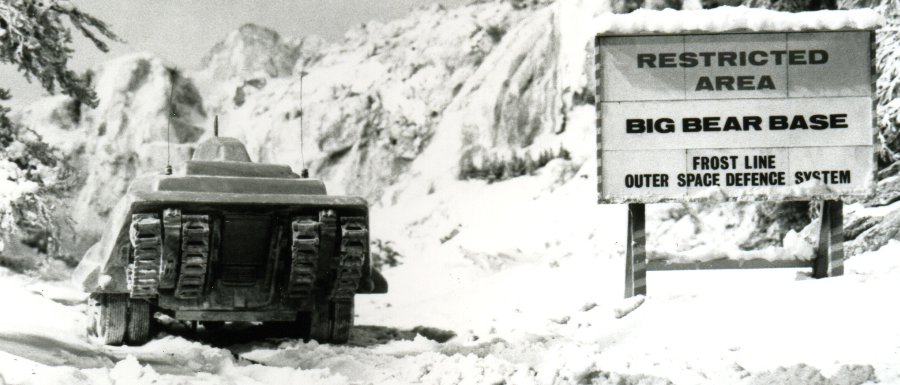 |
David:
With ‘Captain Scarlet’
they introduced the more life-like puppets.
Ian: Yes, a lot
of people thought that they lost something then. When we
first saw them we thought the heads were too small, they
were actually the right scale but I always thought they
were too small - and even looking at them now I still get
that feeling! And I think a lot of people believe that
that was a mistake to make them look too realistic, and
to have kept the characterization of the bigger heads, it
worked better for what they were.David: Here’s another daft
question but I have to ask. On ‘Captain
Scarlet’ the SPV
had tracks on the back that pivot down, but they were
never used. I wonder if it was an effect that
couldn’t be made to work?
Ian: I can
never remember those tracks going down at all, certainly
not in any of the episodes that I was involved with. I
think it was something that was possibly designed because
it looked good, but I can’t remember them ever being
used while I was there. I think comments were made by a
few of us at the time about ‘What are those tracks
for’, and people just looked at each other and
‘Well they do nothing so lets carry on’
(laugh).
I
remember one day that some comedian had gone up into the
roof and put two large eyes there and underneath had
written ‘Derek Meddings is a Mysteron’ (laugh).
But no one ever admitted to it.
David: I believe that you worked on ‘Doppelganger’.
Was it good to be working on a ‘proper’ film
with real actors?
Ian: Yes that
was good to work on, once again it was a bit bigger
budget than the TV programs and we had a chance to do
more things. I’d been at the studios since ‘Stingray’
so I was one of the longest serving members there and it
was nice to be getting into other things and doing
‘floor effects’, which is something that I did
in the later years, moving away from the model work and
into the big practical floor effects with real people.
You were meeting actors that you had only seen on the big
screen, like Ian Hendry, Patrick Wymark and Roy Thinnes -
who at that time was the star of an American series (‘The
Invaders’) and was a big name.
|
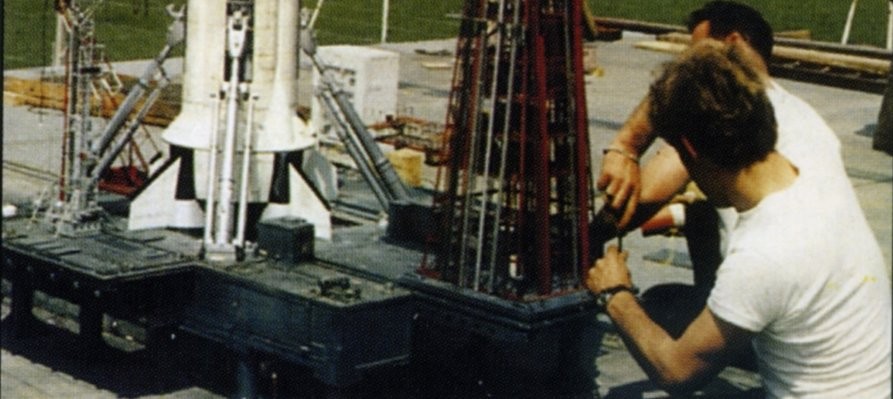 |
| Above; Ian prepares
the rocket miniature for launch, filmed outside to get
the real sky background |
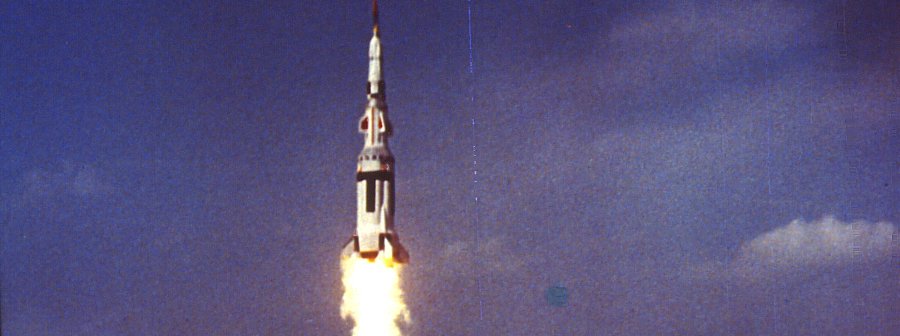 |
| So it was more like the
glamour side of the business and nice to be doing it, and
once again the models were bigger and there was better
stuff to do. Like for the rocket take-off where we built
it outside between the two stages, and we had two big
40-foot towers with a ladder beam across for the rocket
to be pulled up on, so you were looking up at real sky
away from the Slough Trading Estate. Unfortunately
something happened on the first take and it got jammed on
the launch platform. When we fired the rockets the
support arms were supposed to jump back to release the
vehicle and then off it went. However when we were
shooting it the arms didn’t move, I can’t
remember exactly what the problem was but one of the
cables must have snapped. So suddenly we were sitting
there and found that we couldn’t move it, and those
rockets were going and once they ignite that’s it.
There were three 2-inch diameter rockets in that thing,
they we BIG, and they did quite a lot of damage. And you
couldn’t really put it out easily, just trying to
get up to the model in the first place was hard work and
then spraying it to try and put it out, by the time you
got there the damage was already done! David: Did you have any problems
keeping the miniatures in focus?
Ian: Yes you
did. One of the things you do is split your focus so that
you try to hold the background and foreground reasonable
well in focus. Because if you focus like say in a normal
film where they are focusing on the actors you can notice
that the background often goes soft, or if they’re
talking to a character in the foreground they can go a
bit soft. With ours, to try and make it look more
natural, we used to try and split the focus and to do
this we used to use wide-angle lenses all the time. So
rather than keep the camera still and put on a
narrow-angle lens, where you would have more of a problem
with focus, you would keep using the wide-angle lens and
just push the camera in closer to the set.
David: I think ‘UFO’
was the high point in the effects work, the Shado
Mobiles driving through the forest
looked pretty real.
Ian: I think
that over a period of time we had learnt little things as
we went along, how to shoot the models, how to make them,
what was the best scale, how to weight the models, make
the suspensions so they looked more natural, etc, etc. It
was something that had evolved. On ‘UFO’
I started on the models, because the effects started up
before the live-action, but then I moved more over onto
the live-action effects side of it. I was forever
backwards and forwards between Slough and Elstree with
the car loaded up with bits and pieces, explosives and
such like. In those days Elstree Studio, like Pinewood,
had its own in-house special effects department so I
always used to use one of their guys to help me out,
which was normally Trevor Neighbour.
|
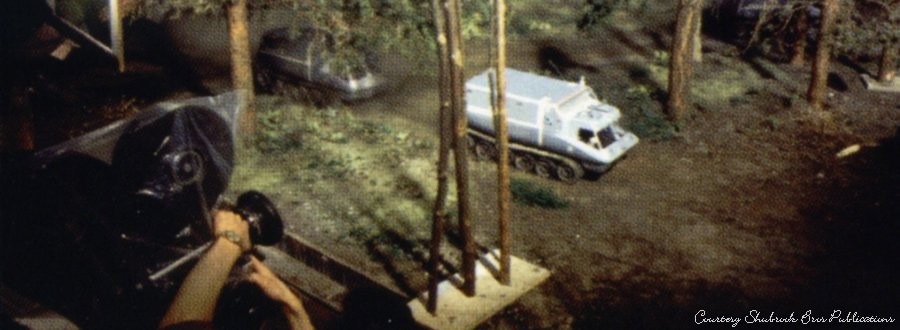 |
| Filming the Shado Mobiles as they hunt for
aliens in the UFO episode
'Computer Affair'. |
David:
When these new models appeared on stage were there any
times that you thought ‘How are we going to make
this work’?
Ian: You used
to get certain ones that were a problem; the worst was
the UFO with the spinning top. We used to think
how the hell are we going to suspend this on wires, and
then keep it steady, because the only way to get a fixing
was from the top bit that didn’t spin. So we would
have a main wire from the centre and splay the wires out
– and sometimes put a wire out to the side to stop
it moving round too much. But it was a pain, every time
to fly that thing was a pain! Also aerodynamically it was
just totally wrong (laugh). On any model you would find
the centre of balance on but on that thing you
couldn’t – I mean if you just held it in your
hand it would be wobbling! |
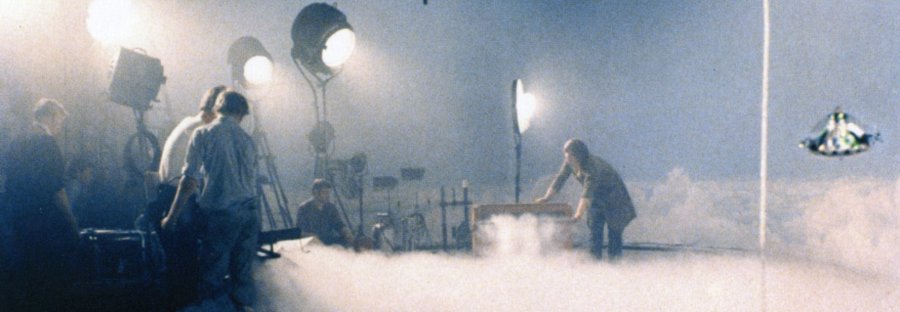 |
David:
The flying effects were slightly different this time with
what looked like real clouds.
Ian: Yes, we
had a base layer of dry-ice and then we would mix it with
different types of smoke, two or three smoke machines
would be used as some would give you a better layer than
others. Plus sometimes you would send the smoke down
through the dry-ice to mix it, so that it would hang
there that bit longer. And you had to time it, and wait
till it was ready, and then you would say 'It looks good.
Turnover, go'. It worked very well. |
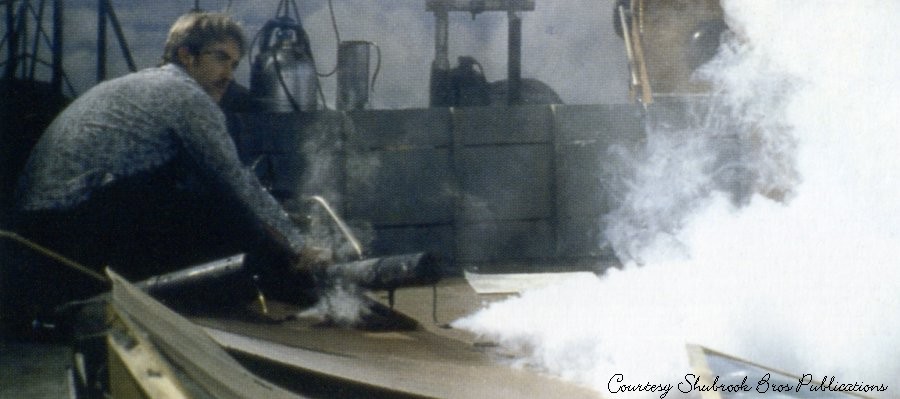 |
| Above; Ian feeding dry-ice and smoke onto
the set |
David:
I think that you had more space to do the ‘UFO’
effects as you had taken over the empty puppet stages.
Ian: I’m
not sure as I think there was an overlap at some point
with some puppet stuff still being done, as they may have
still been filming ‘The Secret Service’.
It was a shame really because they did still have the
opportunity to continue shooting puppets, but Gerry just
didn’t want to know as all through his life he had
wanted to shoot live-action. I think he made a mistake
then and should have found a way to keep shooting the
puppet stuff, trimming it down so that it wasn’t so
expensive. That way I think it could have carried on for
several more years. However you have to give him credit
with what it did at the time, but I guess he had a
love-hate relationship with the puppets and just wanted
to get away from them and do live-action only – and
he did shoot some good live-action stuff.David: Did
you see Gerry or Sylvia on the sets much?
Ian: You used
to see them daily. Old Gerry was marvellous because when
I first started he said ‘There will be times when
you are very busy and other times when you’ve done
your thing and are sat down having a cup of tea. I’m
not worried if I come in and find you’re having a
snooze in the corner because if you’re not doing
your job I’ll soon find out. So don’t worry
about seeing me and having to jump up and start working,
because if you have to do that then there is something
wrong.’ And he was marvellous like that. I got on
well with Gerry and I’ve got a tremendous amount of
admiration for him, he gave me my first break and he did
a marvellous job with all those films.
...........................................................................................
|
 |
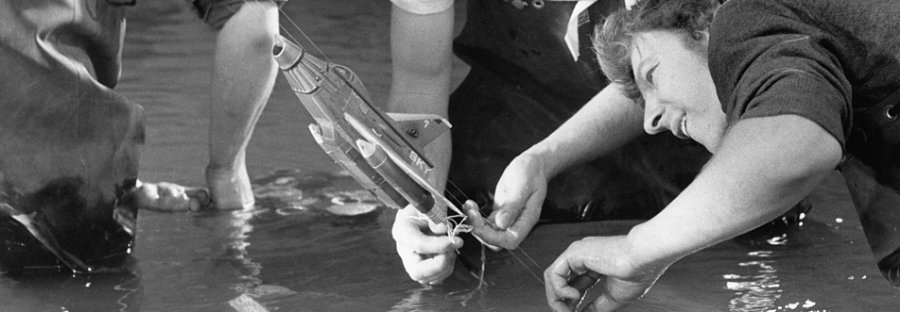 |
David:
When ‘UFO’
was coming to the end did you realise that it was the
‘last’ show?
Ian: It was
difficult to believe I’ll say that. I was one of the
last people there and I can remember having to chuck all
these models in skips and I actually ended up with a Thunderbird
2! We were throwing everything out because in those
days there wasn’t a market for film memorabilia, it
just wasn’t valuable until years later. I saw this Thunderbird
2 and I thought I’m going to have a memento and
so I said to Gerry ‘Could I have something’ and
he said ‘Take what you want’, and so I had it
and everything else was skipped.So I actually had this model but
unfortunately over the years I’ve lost it!
I have had fans of ‘Thunderbirds’
phoning me to say ‘We’re heard you have this
model would you be interested in selling it’. So I
went to look for it as I thought it was in the loft, or
down where I store my equipment, and I just couldn’t
find it. So I asked my wife and she said ‘I think
you threw it out during one of your famous
clearouts’ – can you believe me doing that?
David:
It would probably be worth about £50,000 now!
Ian: Tell me
about it (laugh). But I do now bitterly regret not having
that Thunderbird 2. I’d love to have it, not
necessarily to sell it, but just to have it. Because that
was an important part of my life, where I first learnt
about special effects. It was like a film school and you
were paid to learn these things, and it was so much fun
working on those models and it was so creative. I really
enjoyed it there and it was a great bunch of people. Good
days, they really were good days.
|
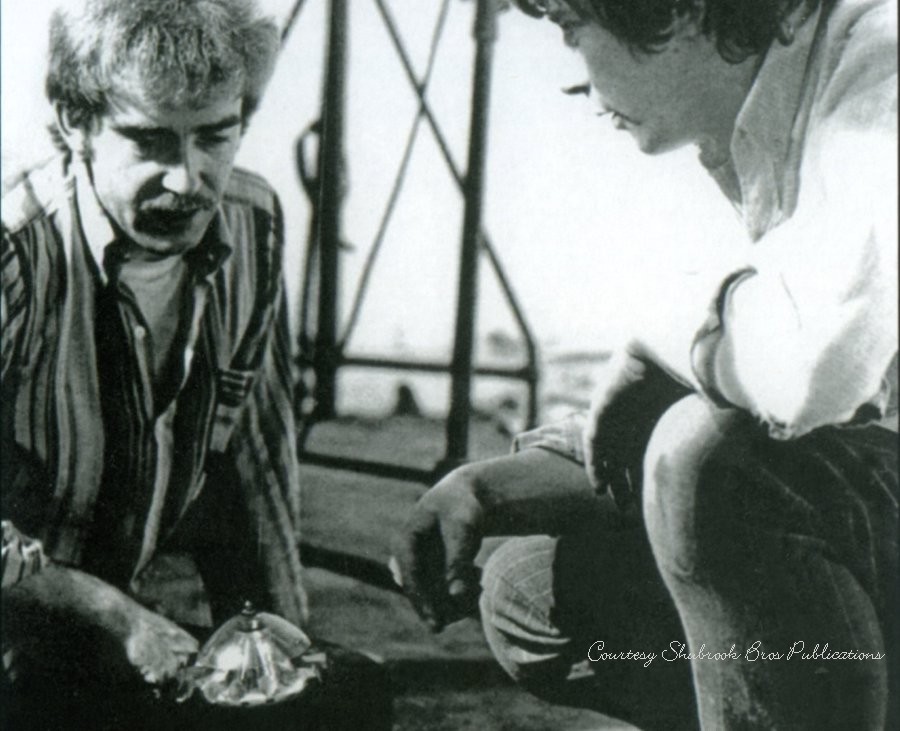 |
| Above left, Ian
examines a UFO miniature prior to filming |
I would like to thank the following
Ian
Wingrove for kindly inviting me into his home and
answering every question I could think of!
Dennis
Lowe
for his enthusiasm and taking the time to arrange and
film the interview. |

